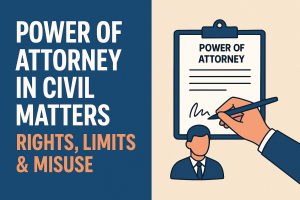In India, a civil suit is a legal proceeding initiated by an individual or entity seeking enforcement of a private right or compensation for a civil wrong. Civil suits may pertain to disputes over contracts, property, family rights, torts, or other non-criminal matters. The process of filing and pursuing a civil case is governed primarily by the Code of Civil Procedure, 1908 (CPC).
This blog provides a step-by-step guide to understanding how civil suits are initiated and proceed through Indian courts.
Step 1: Determining Cause of Action
A cause of action is the legal reason or grievance that entitles a person to file a civil suit. It could arise from:
- Breach of contract
- Encroachment of property
- Non-payment of dues
- Family or matrimonial disputes
Without a valid cause of action, a court won’t entertain the suit.
Step 2: Jurisdiction and Court Selection
Before filing, one must identify:
- Territorial Jurisdiction – Where the defendant resides or where the cause of action occurred.
- Pecuniary Jurisdiction – Based on the monetary value of the claim.
- Subject-Matter Jurisdiction – Whether the court is legally empowered to hear that type of case.
Example: A property dispute over ₹5 lakhs would likely be filed in the District Civil Court, not the High Court.
Step 3: Drafting and Filing of Plaint
The plaint is the formal written complaint that initiates a civil suit. It includes:
- Name and details of parties
- Statement of facts
- Cause of action
- Jurisdiction of court
- Relief or remedy sought
- Valuation and court fee
Along with the plaint, the plaintiff also files:
- List of documents relied upon
- Vakalatnama (if represented by a lawyer)
- Court fee (as per Court Fees Act)
Step 4: Admission and Issuance of Summons
Once filed, the court examines the plaint:
- If it finds merit, it admits the suit and issues a summons to the defendant.
- Summons is a legal notice requiring the defendant to appear and respond.
Step 5: Filing of Written Statement
The defendant must file a written statement (reply) within 30 days of receiving the summons (extendable up to 90 days in certain cases). The written statement must:
- Deny or admit allegations
- Raise defenses or counterclaims
- Provide supporting documents
Failure to reply may result in an ex-parte decree.
Step 6: Framing of Issues
Once both parties have submitted their pleadings, the court frames issues – i.e., points of law and fact in dispute.
Example:
- Whether the defendant was in lawful possession of the suit property?
- Whether the plaintiff is entitled to relief?
Step 7: Evidence and Witness Examination
Both parties are asked to present:
- Documentary evidence
- Oral evidence (witnesses)
Witnesses are examined and cross-examined. Evidence is recorded and forms the factual foundation for judgment.
Step 8: Final Arguments
After evidence is presented:
- Both sides make oral arguments summarizing their positions and interpreting legal provisions.
- Lawyers try to persuade the judge using precedents and logic.
Step 9: Judgment and Decree
After hearing arguments:
- The judge delivers a reasoned judgment, either allowing or rejecting the suit.
- A decree is drawn up to formally record the decision.
Types of Decrees:
Preliminary
Final
Ex-parte
Step 10: Execution of Decree
If the judgment favors the plaintiff, and the defendant fails to comply, the plaintiff may file an Execution Petition under Order 21 CPC.
The court can:
- Attach property
- Issue arrest warrant
- Appoint a receiver
- Enforce specific performance
Additional Stages (If Needed)
Appeals
Aggrieved parties can file an appeal within the prescribed limitation period (usually 30-90 days) in a higher court.
Review or Revision
A party may also seek review (same court) or revision (higher court) on limited grounds.
Alternative Dispute Resolution (ADR)
The court may refer the matter to mediation, conciliation, or arbitration to reduce litigation burden and promote settlement.
Conclusion
Civil suits may seem procedural and lengthy, but they are essential to uphold private rights and provide legal remedies. A well-drafted plaint, strategic legal approach, and proper evidence can greatly improve the chances of success in civil litigation.
If you’re considering filing a civil suit or defending one, consult an experienced civil lawyer to guide you through the process.



